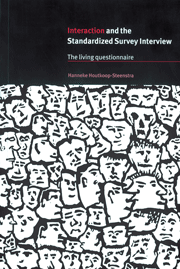Book contents
- Frontmatter
- Contents
- Preface
- Acknowledgments
- Glossary of transcript symbols
- 1 The standardized survey interview
- 2 Interviewer–respondent interaction
- 3 Participant roles
- 4 Recipient design
- 5 Questioning-turn structure and turn taking
- 6 Generating recordable answers to field-coded questions
- 7 Establishing rapport
- 8 Quality of Life assessment interviews
- 9 Implications for survey methodology
- Notes
- References
- Subject index
1 - The standardized survey interview
Published online by Cambridge University Press: 22 September 2009
- Frontmatter
- Contents
- Preface
- Acknowledgments
- Glossary of transcript symbols
- 1 The standardized survey interview
- 2 Interviewer–respondent interaction
- 3 Participant roles
- 4 Recipient design
- 5 Questioning-turn structure and turn taking
- 6 Generating recordable answers to field-coded questions
- 7 Establishing rapport
- 8 Quality of Life assessment interviews
- 9 Implications for survey methodology
- Notes
- References
- Subject index
Summary
Introduction
Social science research is primarily devoted to describing and analyzing peoples' actions and attitudes. In modern states, governments need this information in order to make well-founded policy interventions and evaluate their effectiveness. For example, governments may want to know parents' attitudes towards the schooling of their children and whether or not proposed changes will meet with approval. Also, political parties need to know what issues their prospective voters consider important in order to adapt the election strategies accordingly. In addition, industries may want to know what the trends in fashion will be in two years time, in order to purchase the appropriate materials and dyes.
To gather such information, researchers may send people a questionnaire to fill out and return. Another increasingly popular procedure is to interview people, either in person or, far more economically, by telephone. In the 1980s, personal computers led to the introduction and rapid development of computer-assisted telephone interviewing (CATI).
Among the different types of research interviews, the standardized survey interview is the most prevalent one in use in western societies. Large numbers of people earn an income in the survey research industry, enormous amounts of public and private money are spent in this field, and many important decisions made by governments and companies are based on the results of survey research. In fact our lives are ruled by survey research to a considerable extent.
- Type
- Chapter
- Information
- Interaction and the Standardized Survey InterviewThe Living Questionnaire, pp. 1 - 16Publisher: Cambridge University PressPrint publication year: 2000
- 1
- Cited by

